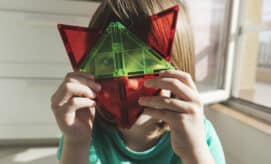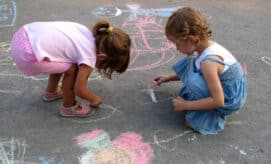From music in a song to tiles on the floor – patterns are everywhere! Young children have a knack for noticing these patterns at an early age. In fact, research studies reveal that, from as early as infancy, children enjoy looking at patterns. Not only is pattern recognition a fun activity for young children, but it is also a foundational part of early mathematical skills. In this article, we share a few pattern-themed activities and picture books for facilitating learning with the little ones in your care.
Patterns & Early Academics
Early pattern recognition skills are foundational for early learners, enabling them to explore more complex math concepts in elementary school. In an article for DREME, Linda M. Platas, an associate professor at San Francisco State University who researches early mathematical development, explains, “Mathematics has sometimes been called a science of patterns. We think of mathematics as having structure, and that structure enables us to solve problems. The structure is built around looking for and manipulating patterns…Pattern is considered an early building block in algebra. The ability to generalize patterns contributes to children’s later understanding of algebraic equations.”
Early literacy is also built upon skills that young children develop as they learn to recognize patterns. This link between patterns and literacy is explained by science-based website Vroom.org: “Looking for patterns encourages [children] to focus on their surroundings…Focusing, paying attention to details, and making sense of symbols are the basics of learning to read and write.”
Simple Activities for Exploring Patterns
Patterns are everywhere! Following are some simple ways to help the little ones in your care spot patterns in the world around them.
- Sing and listen to songs that have repetitive patterns, such as Head, Shoulders, Knees and Toes, or The Chicken Dance. Each of these songs follow a simple, predictable pattern of movements that children can follow as they enjoy a fun, physical activity.
- Vroom recommends using a spare muffin/cupcake tin to practice making patterns with little ones: Look for things that can fit inside each hole, like pen caps. Make a pattern, like one red cap in a hole, then two blue caps in another, then another red cap. Then give the caps to your child. Can they match the pattern?
- Blocks and other classroom materials can be used to create a pattern game. You might, for example, invite the children to watch you make a pattern as you put down a red block, and then a blue block, followed by another red block, and an additional blue block. Then, ask the children to pick which color would come next. Once children seem to have a good grasp on the activity, add another color to create a longer sequence! This activity can also be done with pom-poms, crayons, buttons, different shapes of dried pasta, and more, depending on what you have available.
- When you notice patterns on clothes, such as stripes on a shirt or a print on someone’s jacket, point them out to children and discuss them! Encourage the children to guess what will come next by saying things like “Alex’s shirt has a green stripe, then an orange stripe, then a white stripe. Green, orange, white, green, orange, white, green…what color comes next in the pattern?”
Pattern-Themed Picture Books
Below, you will find examples of children’s books that depict and explore patterns. To expand learning during storytime, discuss the patterns that you see as you read the stories with the children in your care. Encourage children to complete the patterns by predicting which colors or items will come next!
Pitter Pattern









